Frequently Asked Questions
Finance
What will this cost me?
The $58,950,000 equates to a 3 mill increase in 2015. This is 3 mills on the taxable value of your home, not the total value. Each homeowner’s cost may be different depending on filing status, age and other income tax variables. An example: A home worth $200,000 typically has a taxable value of $100,000. 3 mills levied on this home would cost $300/year, before any income tax considerations. However, your costs may be less.
What will the bond really cost over 25 years?
The estimated millage that will be levied for the proposed bonds in 2015 is 3.00 mills ($3.00 on each $1,000 of taxable valuation).
Explanation: The State requires school districts to use a formula to calculate the estimated average cost of mills over the life of the bond. In order to determine the rates (mills), the statutory requirement is to use the last five years of average taxable value growth/negative growth to determine the next five years of taxable value growth. The past five years showed a negative growth in district taxable value (including homes, commercial, etc). This results in an estimate of negative 2.39% per year decline in taxable value growth for the next five years (or nearly 12% in total for the next five years). The 4.15 mills average estimate is based on the negative growth in home values based on the previous five years. However, Oakland County is projecting a 4.4% growth over the next four years. That projection shows that the estimated 4.15 mills average is highly unlikely, however, the District is statutorily required to include that number on the ballot.
Where does the District stand in the county for mills levied?
The Berkley School District is currently third from the bottom of Homestead Tax Rates out of 28 districts in Oakland County. If the 2015 Bond Proposal is passed, the District will remain in the lower half of all districts.
What Can Bond dollars used for?
Under current law, bond dollars may be used for construction and remodeling of facilities, purchasing technology equipment, equipment and furniture, and site improvements.
What can't Bond Dollars be used for?
Bond dollars cannot be used for operational costs such as: salaries and wages, maintenance, classroom supplies and textbooks.
Facilities
Have the buildings been maintained?
Our custodial and maintenance teams work extremely hard to keep our aging buildings up and running for our students. In fact, they have been able to keep boilers running 20+ years after their life expectancy. The Berkley School District utilizes a Sinking Fund for maintaining all buildings (approx. $680K/year). This money is used to repair roofs, leaks, pavement, purchase electrical parts and more. $680K helps with repairs and immediate needs but isn’t enough to do full replacements of big purchases like boilers.
Why have Sinking Fund dollars been used to repair athletic items, such as the Hurley Field turf, instead of other spaces listed in the report?
Sinking Fund dollars may be used primarily for the construction or repair of school buildings and facilities, acquiring or installing technology (wiring or materials for installing), and the purchase of real estate sites. Each year the custodial maintenance staff prioritizes needs in the District that are eligible for Sinking Fund work. Recently, the Hurley Field turf was updated because it had reached the end of its life, and was getting near the low end of the safe range of safety score. Many students and community members use Hurley Field. The turf was updated as part of a regular life-cycle improvement and to ensure user safety. Other recent Sinking Fund projects include BHS auditorium seating/related improvements, boiler repairs, new lockers, roofing/parking lot/concrete replacement projects, technology infrastructure improvements and lighting/energy improvements.
Why not fix everything in the IDS report?
The IDS report called for $120M in needs. A bond for $120M is too much for a few reasons.
- Not everything in the report was considered a “must have.”
- It’s important to balance the ideal vs the practical when it comes to selecting work to be done.
- This plan is reasonable and thoughtful, something the community has asked for.
General
Who created the plan for the Bond Proposal?
In September 2014, the District created a 70+ person committee of community members (including parents, those without children, and senior citizens), students and staff. Stantec, along with McCarthy & Smith, using the IDS report and the District’s Strategic Plan, led the Stakeholders Committee through seven meetings over two months to create a plan for facility and technology improvements. This plan was presented to the Board of Education for approval in December 2014.
Why does Berkley Schools participate in Schools of Choice (SOC)?
The Schools of Choice program allows students in grades K-5 who do not live in the Berkley School District boundaries (but do live in Oakland County) to attend Berkley Schools. Berkley Schools participates in SOC for four main reasons:
- Adding Schools of Choice students creates optimal enrollment in our schools, allowing schools to remain in the neighborhoods. Without SOC students, reconfiguration of schools would most likely be necessary.
- Schools of Choice students help spread fixed cost over more students (optimal enrollment).
- Schools of Choice students allow for deep and rigorous programming. The additional SOC students at Berkley High School, for example, create a critical mass of students to allow scheduling for 21 AP classes, Calc III, Syracuse University Freshman English course, Zoology, and a robust music program.
- Schools of Choice students generate over $7 million per year with their foundation allowance. $7 million is 14% of the District’s overall budget. If 14% of the budget was eliminated major cuts to programs would occur.
Do we accept every student who applies for Schools of Choice (SOC)?
No. Last year the Board approved 145 SOC slots. We accepted 96 students in grades K-5 (based on space availability per grade) and turned away over 200 students.
Neighboring school districts reduced Schools of Choice (SOC) numbers. Did this work for them?
Some neighboring districts reduced their Schools of Choice number significantly over the past few years. The result was the district endured major cuts to its budget, reducing staff and eliminating programs. Since then, some of these districts have returned to their original SOC slots of students allowed, and increased the grades students are allowed to enter their district. Reducing SOC numbers for these districts created a downward spiral of cutting budgets, dipping into fund balance, and lower enrollment of resident students.
What is the last day to register to vote?
The last day to register to vote is April 6, 2015.
What is the last day to pick up an absentee ballot from my City Clerk’s Office?
The last day a ballot can be mailed or taken from the City Clerk’s Office is 2:00 pm on the Saturday before the election, (May 2, 2015).
Where can I view the ballot language?






